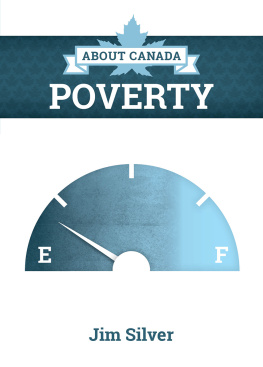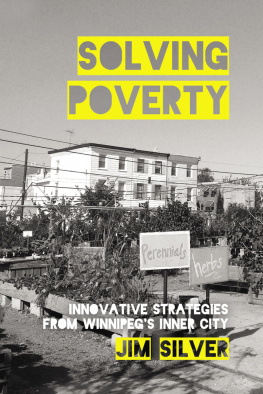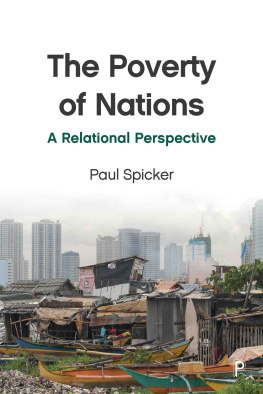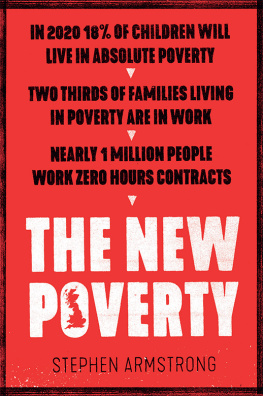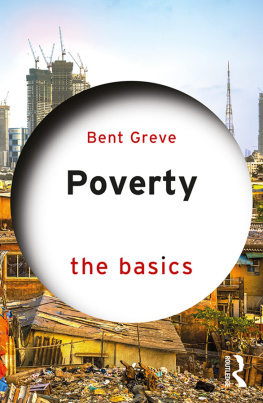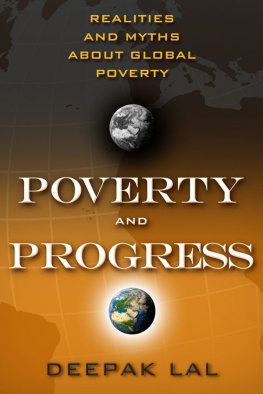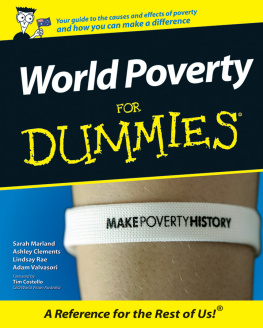
POVERTY

POVERTY
Jim Silver

HALIFAX & WINNIPEG
Copyright 2014 Jim Silver
All rights reserved. No part of this book may be reproduced or transmitted in any form by any means without permission in writing from the publisher, except by a reviewer, who may quote brief passages in a review.
Editing: Curran Faris
Design: John van der Woude
Printed and bound in Canada by Hignell Book Printing
eBook development: WildElement.ca
Published in Canada by Fernwood Publishing
32 Oceanvista Lane, Black Point, Nova Scotia, B0J 1B0
and 748 Broadway Avenue, Winnipeg, MB R3G 0X3
www.fernwoodpublishing.ca
Fernwood Publishing Company Limited gratefully acknowledges the financial support of the Government of Canada through the Canada Book Fund and the Canada Council for the Arts, the Nova Scotia Department of Communities, Culture and Heritage, the Manitoba Department of Culture, Heritage and Tourism under the Manitoba Publishers Marketing Assistance Program and the Province of Manitoba, through the Book Publishing Tax Credit, for our publishing program.

Library and Archives Canada Cataloguing in Publication
Silver, Jim, 1946-, author
About Canada : poverty / Jim Silver.
(About Canada series ; 10)
Includes bibliographical references and index.
ISBN 978-1-55266-681-4 (pbk.)
1. PovertyCanada. 2. PoorCanada. 3. CanadaEconomic policy. 4. CanadaSocial policy. 5. NeoliberalismCanada. I. Title. II. Title: Poverty. III. Series: About Canada series; 10
HC120.P6S55 2014 362.50971 C2014-905175-1
CONTENTS
To our newest grandson,
the wonderful Odin Silver
ACKNOWLEDGEMENTS
I am happy to acknowledge the many people I have had the privilege of working with on poverty-related issues over many years. I am particularly grateful to those that I have worked with in Winnipegs inner city, especially at Lord Selkirk Park and the Selkirk Avenue education hub, but in numerous other inner-city projects as well. There are too many to name, and if I start I will surely miss some of you. Thanks to all of you for your friendship, your dedication and your hard and skillful work. I am grateful as well to the many wonderful people at the Canadian Centre for Policy AlternativesManitoba and the Manitoba Research Alliance, and I want in particular to thank Shauna MacKinnon, Lynne Fernandez, Elizabeth Comack and John Loxley, from each of whom I have learned a great deal and who have been a constant source of support over the years we have worked together.
I want to acknowledge the specific and excellent research support of Matt Rogers, with whom I have worked on previous research efforts. Thanks Matt.
I am pleased to acknowledge the generous financial support of the Social Sciences and Humanities Research Council of Canada through the Manitoba Research Alliance grant titled Partnering for Change Community-Based Solutions for Aboriginal and Inner-City Poverty.
Once again, I am pleased to acknowledge the support of all of the people at Fernwood Publishing involved in this project, Beverley Rach, Curran Faris and especially my good friend Wayne Antony, for their work on this book and their continued support of my work. Thanks also to John van der Woude for designing the cover of this book.
Most importantly, thanks to Loa Henry, my partner in all things for many years, for her ongoing love and support.
1
FORMS OF
POVERTY
I t has often been said that poverty will always be with us. Perhaps it will. I dont think it need be. In a country as wealthy as Canada, we could largely eliminate poverty if governments and the citizens who elect them were to choose to do so. Eliminating or at least dramatically reducing poverty is a matter of political will. Rates of poverty in some industrialized countries the Nordic countries in particular are very low, while those in other industrialized countries Canada for example, and especially our neighbour the United States are very high. This suggests the possibility that different ways of doing things different societal arrangements, different public policies produce different levels of poverty.
That poverty need not always be with us is further suggested by the fact that in some societies there has been no poverty at all. Thomas Berger quotes a French Jesuit writing about the Iroquois in 1657 :
No hospitals [poorhouses] are needed among them, because there are neither mendicants or paupers as long as there are any rich people among them. Their kindness, humanity, and courtesy not only makes them liberal with what they have, but causes them to possess hardly anything except in common. A whole village must be without corn, before any individual can be obliged to endure privation.
Some might argue that there was no poverty in such societies because everyone was poor. This would represent an especially narrow and limited understanding of poverty one that sees poverty as simply a shortage of money and of the commodities that money can buy. Yet Mohawk society, including all of its members, was rich not poor in many fundamentally human ways. Poverty is often about more than a shortage of money.
What exactly is poverty, then? There are important debates in Canada about how to measure poverty, and in the next chapter I will describe the various positions in these debates. But the differing positions in these debates all revolve around poverty as being a shortage of money. I will argue that, as important as money is in a monetized society such as ours in Canada, there are forms of poverty that are about more than a shortage of money. Poverty is often complex, and multi-faceted, and can damage the human spirit in ways that are profound.
THE POVERTY CONTINUUM
I will break up the concept of poverty into two broad categories: the poverty related only to a shortage of income, and that which is more complex, including a multitude of factors that worsen povertys impact. These should not be thought of as two airtight and mutually exclusive categories. Rather, they are better considered as a matter of degree, or as existing on a continuum, with poverty as a shortage of income, often a temporary phenomenon that may not cause lasting damage to those who experience it, at one end of the continuum a student whose income is relatively low during her years at university, for example and at the other end of the continuum is poverty as a more complex, multi-faceted, long-term and even intergenerational phenomenon that includes a shortage of money but much more and produces great damage to those who experience it.
When we think of poverty as a shortage of income it is useful to differentiate between absolute poverty and relative poverty. Absolute poverty occurs when people have so little money that they cannot acquire the bare necessities of life. This is not the most common form of poverty in Canada, although it certainly does exist think of Canadas many homeless people, sleeping on the streets or in crowded shelters and when it does, it produces many of the negative consequences associated with what I am describing as complex poverty. Relative poverty, by contrast, occurs when peoples income is such that they can acquire some or most of the bare necessities of life, but are excluded from anything resembling a normal life.

